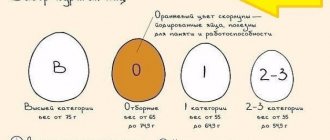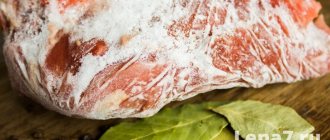Regardless of the time of year, you can buy almost any vegetables and fruits in stores. And in order for these products to retain their presentation, freshness and maximum vitamins, you need to adhere to the rules for their storage. In this article, I will share with you my experience of storing vegetables and fruits in the refrigerator, pantry and on the balcony, and also tell and show you little tricks that help protect food from spoilage.
To prevent vegetables and fruits from absorbing each other’s smell, they should be stored separately (on different shelves of the refrigerator, in special containers, boxes, bags, etc.).
Potato
It is best to store potatoes in a dark, cool place with good air circulation. To prevent sprouts from appearing on the tubers, put 2-3 apples in a bag or box with potatoes. The apple absorbs moisture faster and the potatoes will not germinate. My potatoes are stored on the balcony in a plywood box insulated with foam plastic. When there is severe frost outside, I cover the box with a sheepskin coat.
It is not advisable to store potatoes in the refrigerator, because moisture and cold negatively affect the taste of the tubers.
Sorting
Before you start optimizing everything, you should divide things into necessary and unnecessary. First, you should get rid of things that have not been used for a long time. Each of us has some kind of toaster, which was last turned on a couple of years ago, while it was tightly located on the windowsill in the kitchen. It’s better to throw away such things, sell them through Avito, or give them to someone who will use them. This way, only the necessary items will remain - we will plan storage space for them.
The necessary things will also have to be sorted. There is, for example, a hot and cold rotation system. The hot rotation includes those things that should be at hand every day. These are clothes, shoes and household gadgets - from a vacuum cleaner to an ironing board. To correctly calculate the dimensions of your wardrobe, measure the linear meters of the bar for long items (outerwear, dresses), and separately calculate the meters of the bar for short items (shirts, blouses, jackets). Also determine the volume of shelves for other clothes and shoe boxes.
Cold rotation items include suitcases, boxes, Christmas tree decorations and other seasonal items. You can put your home library in the same category if you don’t access it every day, and household items that are dear to your heart—everything that can be put away.
Pumpkin
I also keep a pumpkin on the balcony. I have it insulated, and the temperature in not too cold winters stays within 10-12 degrees. I covered the floor with paper, laid out the pumpkin and covered it with a dark blanket. After all, it is also advisable to store it in a dark place where direct sunlight does not reach. But since January of this year turned out to be very frosty, I moved the pumpkin into the room and placed it in the corner near the balcony, naturally, away from the radiator. If I left the pumpkin on the balcony, where the temperature dropped to 0-2 degrees, or maybe lower, the orange beauty would begin to turn black and rot.
Cabbage
I store white and blue cabbage in a cool place, wrapping the heads in paper. I don’t remember where I heard this advice, but I liked the fact that it almost doesn’t spoil (the top leaves dry out a little). And so that it does not take up much space in the refrigerator, I put it on the balcony, wrapping each head of cabbage in paper. Do not use newspapers; the ink from printing can be absorbed into the vegetable, and consuming such products is very dangerous.
Onion
I store onions of different varieties (Yalta or red, shallots, onions) separately from each other. The room should be dark, dry and cool (temperature no higher than 18 degrees). I have a separate large basket for onions; the air is well ventilated in it, and I can always quickly select the desired size of onion. I’m not a fan of hanging onions in nylon tights or nets; it’s not very convenient to get them out of there. I have these baskets in my pantry.
Carrot
I never wash carrots; I store them the way they were dug up in the garden, that is, in the ground, sand or clay. The fact is that carrots have thin skin and by washing the vegetable, you shorten its shelf life. Carrots are perfectly stored in the refrigerator in a plastic bag at a temperature of +2 - +5 degrees for two to three weeks.
If you have a private house, basement or cellar, then do not be lazy to make a box with sand for the carrots and store it in it (completely immersing the carrots in the sand; with this storage, the carrots, after being removed from the sand, are no different from those just dug up in the garden) .
How to prepare vegetables for storage
Before storing vegetables, they must be carefully prepared. Preparing fruits for long-term storage includes the following steps:
- Cleaning . Clean the vegetables removed from the garden from tops, spoiled parts (for example, rotten cabbage leaves) and adhering clods of earth.
- Drying . All vegetables must be thoroughly dried before storage. For some fruits, it is enough to lie for 1-3 days in a dry, well-ventilated area (potatoes, beets, carrots), while others should be kept in similar conditions for several weeks (onions, garlic). Undried vegetables will not store well and will begin to rot.
- Sorting . Before storing, conduct a thorough audit of your inventory. All diseased and rotten vegetables should be thrown away immediately. Fruits with mechanical damage should be consumed first, because... they are poorly stored. Only completely healthy and ripened fruits can be stored for a long time.
Beet
Beets are perfectly stored in any cool place: the bottom shelf of the refrigerator or vegetable compartment, balcony, basement or cellar. Store it in a box, bag or bag. If I buy a lot of beets, I store some in the refrigerator, some on the balcony. The main thing is to protect the vegetable from direct sunlight.
I store radish, celery root, and horseradish root in the same way.
By the way, root vegetables cannot be stored cut, because this way they quickly deteriorate, dry out and rot. If you have half a beet, part of a carrot or celery root left and nowhere to use them, freeze the vegetables. Cut into cubes, strips or grate, put in a bag and put in the freezer. In the future, when cooking soup or stewing a dish, you will have a useful preparation.
Useful tips
@kitchendecorium.ru
To make it easier to follow the rules, there are the following tips.
- Wrap food in film. The cling film will prevent the smell emanating from the product from spreading, and will also allow the product to maintain its fresh appearance without losing moisture. An alternative to film can be foil or airtight containers.
- To track expiration dates, you can use the restaurant method: stick on special stickers with the date the package was opened or the food was prepared to make sure you don’t eat anything spoiled.
- It is recommended to wipe the refrigerator shelves with a damp cloth at least twice a month. If there is an unpleasant odor inside the refrigerator, you can add a dash of lemon or soda to the water.
These rules and tips will help you maintain the freshness, taste and beneficial properties of foods stored in the refrigerator.
Apples
I store apples in a cool place. I feel more comfortable on the balcony. You can also put it in the refrigerator, but then there is no room left for other products. It is very convenient to store apples in a cardboard box, box or basket, separating them with plain paper so that rot or spoilage does not spread to other fruits. If the volume of apples is small, less than 3-4 kg, then paper may not be used.
Temperature and shelf life of food in the refrigerator
| Products | Shelf life (days) | Temperature (°C) |
| Greens, berries | 2 | 4–6 |
| Fruits | 30 | 2–4 |
| Butter, margarine | 20 | 2–4 |
| Eggs | 20 | 2–4 |
| Cheese | 14 | 2–4 |
| Cottage cheese, sour cream | 3 | 4–6 |
| Milk, kefir | 1 | 4–6 |
| Raw meat | 5 | 2–4 |
| Fish | 1–2 | 0 |
| Ground meat | 1–2 | From 0 to -2 |
| Boiled sausage, sausages | 3 | 3–4 |
Tomatoes
I never store tomatoes in a special compartment with other vegetables. And in general I don’t put it in the refrigerator. For some reason, after being in the refrigerator, tomatoes become tasteless. So I store them in a container with holes on the kitchen cabinet shelf. By the way, it’s cool in my kitchen, the temperature is between 18-19 degrees.
I also don’t buy large quantities of tomatoes; I always try to use them in a salad or dish so that they don’t sit out for a long time.
Items that should not be kept at home
Skins, skulls, antlers and stuffed animals are things that represent death. They have a destructive aura.
Other people's jewelry. Natural stones are capable of storing information about their former owner. Negative energy can harm your health. Buy stones only from trusted people. The same can be said about antiques.
Aggressive figures of animals with open mouths have a negative impact.
Broken dishes and broken mirrors draw out positive energy, bringing need and lack of money into the house.
Pay attention to the elephant figurine. A raised trunk attracts good luck to the house, a lowered trunk brings depression and despondency.
Don't delay the past with old calendars and stopped clocks.
In Eastern cultures, it is believed that neatly maintaining a home can attract monetary wealth. It's no secret that cleanliness is the key to health. Order in things and neatness will give the house comfort and a positive atmosphere.
Garlic
The biggest hassle I had was storing garlic. The fact is that until the New Year, garlic heads are stored perfectly in the refrigerator, on the balcony, and in the pantry. But January-February comes, and the garlic begins to sprout, the cloves wither, deteriorate and turn yellow. Whatever I tried.
Two methods helped: burn the place where the roots sprout over the burner and sprinkle the garlic cloves with salt or flour. I always have a jar like this in the refrigerator - it contains garlic cloves in their husks, sprinkled with flour. You can also peel the teeth, put the garlic in a jar and add vegetable oil. It turns out that time has already been saved on peeling the garlic, and the aromatic oil can be used for frying other products.
cucumbers
I like to eat cucumbers cold. But many argue that they cannot be stored in the refrigerator. Yes, if you store them in a closed bag, they spoil faster and become tasteless, and without the bag they quickly wither. I store them on the refrigerator door, putting them in a bag and opening it slightly so that the cucumbers can breathe. Why on the door? So this is the warmest place in the refrigerator with a temperature of about +8 degrees. I am satisfied with this result; the cucumbers do not wither and do not change their taste. This way I keep them for up to one week.
Don't buy more cucumbers than you plan for a salad or other dish. Cucumbers quickly wither, and it may turn out that you just wasted your money.
Lemons
Here, on the refrigerator door, I have lemons. To prevent them from spoiling, I don’t put them in a bag. As you can see, the cut lemon is lying cut side down on my saucer. To prevent the cut from drying out, I dip the lemon in sugar and place it on a plate. And if you need lemon for a savory dish, then I dip it in salt and also store it on a saucer, cut side down.
I most often store tangerines and oranges on the balcony. And when there are very few of them left, I put them on the refrigerator door without a bag.
Nuts
One thing I have a lot of is nuts. We collect the harvest in bags, so we want to keep everything intact and not spoiled. The best storage method is in a cool and ventilated place. No plastic bags, cans, or plastic containers. I store it on the balcony in a box.
I also have a lot of “drying”, and I have more than once fought with moths that flew out of bags of dried apples. And then I began to store it in the cold and always in a linen bag, in which I put several dry mint sprigs. The photo shows that the bag with the “drying” is hanging on the balcony in the corner above the nuts.
Despite all the tips and tricks for storing fruits and vegetables, you should remember that they are best consumed fresh, when they are at their healthiest and tastiest. Try to correctly calculate the amount of vegetables and fruits that you will need within two to three weeks.
I hope my article was useful to you.
What to do to prevent moths from getting in?
- In glass jars, before placing the fruit, you need to place a small circle (or any other shape) of wax paper. It will protect dried fruits not only from moths, but also from other bugs. On a note! If you use fabric bags, then you should wash them first in a saline solution. And, of course, dry without rinsing! Then they will be inaccessible to moths and other insects.
- Advice! First, the jars should be rinsed with vinegar. It will disinfect, remove odors, and protect from pests.
- By the way! If there are moths in your dried fruits, do not throw everything away at once. It is worth sorting out the fruits and placing those that the insects have not yet damaged, in the freezer (for about a day). Because the moth and its larvae die at temperatures below -2 °C.
Storing dried fruits
And, of course, another important condition is the storage time of dried fruits. Each fruit has its own expiration date, so it is worth considering this issue in more detail.
- There are two types of raisins - black and light (raisins). In principle, they do not differ in service life.
- At the optimal temperature (it was already indicated above that it ranges from 2 to 10 °C), raisins can be stored for about 2.5 years.
- If the temperature does not exceed 18-19 °C, then the shelf life is naturally reduced to 1 year.
- Well, a higher temperature reduces the storage time of raisins to 6 months.
- Dried apricots and prunes have a similar and slightly shorter shelf life.
- Up to 10 °C they will last on the shelf for only 1 year.
- If the temperature is up to 18 °C, the shelf life will be reduced to six months.
- And, naturally, at temperatures above 18 °C, fruits will last no more than three months.
Storing dried fruits
Another question arises - is it possible to store dried fruits in the freezer? And won’t this affect their usefulness and taste?
- Nowadays it is very popular to store various products in the freezer. Of course, it's much more convenient. After all, the shelf life increases significantly. It is especially good when there is a large separate freezer, in which you can not only place fresh fruits or vegetables, but also, for example, dried fruits.
- Yes, the shelf life is practically unlimited. Just don’t be fanatical – you shouldn’t store prunes or dried apricots in the freezer for three years either.
- It is worth freezing in small portions, which will be in separate containers. For example, in small plastic containers or sealed bags.
- You need to defrost only the required amount and only at room temperature - this is an important condition!
- And be sure to take into account the fact that the product will partially lose the entire list of useful substances. Therefore, it is still better not to freeze dried fruits, if possible. A little advice! If raisins, dried apricots or prunes seem visually questionable. But, at the same time, they do not contain moths or mold, then place the dried fruits in the freezer for several hours. Thus, the product is revived. By the way, you can also resort to high temperatures. That is, you need to place the fruit in the oven for a while. The oven door should not be closed, and the temperature should not exceed 75 °C.
These are the basic requirements for storing dried fruits such as dried apricots, raisins and prunes. In principle, all these tips, which comply with GOST, apply to all types of dried fruits. And the basic standards for a long and most optimal shelf life were outlined above.











